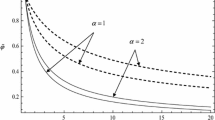Abstract
The electromagnetic field induced by shock compression of a current-carrying conductor is shown to consist of two current waves. One propagates in the uncompressed material at the shock-wave velocity. The other is due to current inward diffusion. As the shock wave propagates, the current passes from the first wave to the second. At large observation periods, the situation resembles conventional current diffusion into a conducting half-space. Control parameters for electrodynamic problems with shock waves are found. Their physical meaning is the ratio between the times of field convection and diffusion in different regions. In specific cases, the problem is reduced to the motion of the surface of a current-carrying half-space and to shock metallization of an insulator.
Similar content being viewed by others
References
H. Knoepfel, Pulsed High Magnetic Fields (North-Holland, Amsterdam, 1970; Mir, Moscow, 1972).
L. V. Al’tshuler, Usp. Fiz. Nauk 85, 197 (1965) [Sov. Phys. Usp. 8, 52 (1965)].
The Physics of High Energy Density, Ed. by P. Caldirola and H. Knoepfel (Academic, New York, 1971; Mir, Moscow, 1974).
W. Marshall, Proc. R. Soc. London, Ser. A 233, 367 (1955).
H. Sen, Phys. Rev. 102, 5 (1956).
J. M. Burgers, in Magnetohydrodynamics: A Symposium, Ed. by R. K. M. Landshoff (Stanford Univ. Press, Stanford, 1957; Atomizdat, Moscow, 1958).
E. I. Zababakhin and M. N. Nechaev, Zh. Éksp. Teor. Fiz. 33, 442 (1957) [Sov. Phys. JETP 6, 345 (1958)].
J. N. Fritz and J. A. Morgan, Rev. Sci. Instrum. 44, 215 (1973).
Yu. N. Zhugin and K. K. Krupnikov, Prikl. Mekh. Tekh. Fiz. 20(1), 102 (1983).
V. V. Pai, I. V. Yakovlev, and G. E. Kuz’min, Fiz. Goreniya Vzryva 32(2), 124 (1996).
Yu. N. Zhugin and Yu. L. Levakova, Prikl. Mekh. Tekh. Fiz. 41(6), 199 (2000).
V. V. Pai, Ya. L. Luk’yanov, I. V. Yakovlev, and G. E. Kuz’min, Fiz. Goreniya Vzryva 36(6), 164 (2000).
S. D. Gilev and T. Yu. Mikhailova, Zh. Tekh. Fiz. 66(5), 1 (1996) [Tech. Phys. 41, 407 (1996)].
S. D. Gilev and T. Yu. Mikhailova, Zh. Tekh. Fiz. 66(10), 109 (1996) [Tech. Phys. 41, 1029 (1996)].
S. D. Gilev, Fiz. Goreniya Vzryva 31(4), 109 (1995).
S. D. Gilev and T. Yu. Mikhailova, Fiz. Goreniya Vzryva 36(6), 153 (2000).
S. D. Gilev, Fiz. Goreniya Vzryva 37(2), 121 (2001).
I. E. Tamm, The Principles of Electricity Theory (Nauka, Moscow, 1989).
V. L. Shevel’kov, Zh. Tekh. Fiz. 16, 207 (1946).
B. Ya. Lyubov, Zh. Tekh. Fiz. 18, 713 (1948).
G. A. Grinberg, Zh. Tekh. Fiz. 21, 382 (1951).
B. Ya. Lyubov, Dokl. Akad. Nauk SSSR 57, 551 (1947).
D. V. Redozubov, Zh. Tekh. Fiz. 30, 606 (1960) [Sov. Phys. Tech. Phys. 5, 570 (1960)].
V. I. Kval’vasser and Ya. F. Rutner, Dokl. Akad. Nauk SSSR 156, 1273 (1964).
É. M. Kartashov and G. M. Bartenev, Izv. Vyssh. Uchebn. Zaved., Fiz., No. 2, 70 (1969).
É. M. Kartashov and G. M. Bartenev, Izv. Vyssh. Uchebn. Zaved., Fiz., No. 3 (82), 20 (1969).
É. M. Kartashov and G. M. Bartenev, Izv. Vyssh. Uchebn. Zaved., Fiz., No. 12, 97 (1970).
É. M. Kartashov and B. Ya. Lyubov, Izv. Akad. Nauk SSSR, Énerg. Transp., No. 6, 83 (1974).
É. M. Kartashov, Analytical Methods in the Theory of Heat Conductivity of Solids (Vysshaya Shkola, Moscow, 1985).
Author information
Authors and Affiliations
Additional information
__________
Translated from Zhurnal Tekhnichesko\(\overset{\lower0.5em\hbox{$\smash{\scriptscriptstyle\smile}$}}{l} \) Fiziki, Vol. 72, No. 7, 2002, pp. 21–27.
Original Russian Text Copyright © 2002 by Gilev, Mikha\(\overset{\lower0.5em\hbox{$\smash{\scriptscriptstyle\smile}$}}{l} \)lova.
Rights and permissions
About this article
Cite this article
Gilev, S.D., Mikhailova, T.Y. Electromagnetic field induced by shock compression of a current-carrying conductor. Tech. Phys. 47, 814–820 (2002). https://doi.org/10.1134/1.1495040
Received:
Issue Date:
DOI: https://doi.org/10.1134/1.1495040



